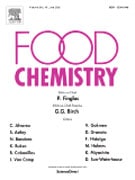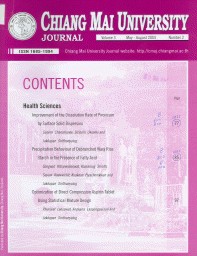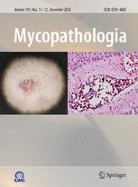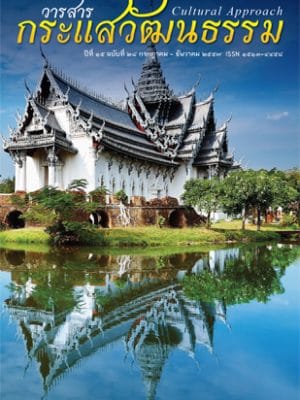
Clinically significant drug interactions among HIV-infected patients receiving antiretroviral therapy (2014)
Abstract
We conducted a cross sectional study of the outpatient medical records of 1,000 HIV-infected patients receiving antiretroviral therapy (ART) in 2011 to determine the incidence of clinically significant drug interactions (CSDI). The severities of the CSDI were graded following the Micromedex® 2.0 database and the Department of Health and Human Services (DHHS) 2012 HIV treatment guidelines. Three hundred thirty-five patients (34%) had 554 episodes of CSDI. Of which 337 episodes (61%), 163 episodes (29%) and 54 episodes (10%) had grades 2, 3 and 4 severity CSDI, respectively. The CSDI were caused by protease inhibitor (PI)-based drug regimens in 79%, by efavirenz-based regimens in 34% and by nevirapine-based regimens in 10% (p<0.001). The three most common grade 4 CSDI were: a PI with simvastatin (n=24), simvastatin with gemfibrozil (n=24) and didanosine with allopurinol (n=2). The three most common grade 3 CSDI were: a PI with a statin drug except simvastatin (n=56), fenofibrate with a statin drug (n=28) and amlodipine with simvastatin (n=14). On multivariate analysis, risk factors associated with CSDI were: receiving a PI-based regimen (OR 14.44; 95%CI: 9.10-22.88), having dyslipidemia (OR 3.94; 95%CI: 1.89-8.21), having >5 items prescribed at a time (OR 1.80; 95%CI: 1.23-2.63), seeing a doctor >4 times a year (OR 1.72; 95%CI: 1.20-2.46), having hypertension (OR 0.60; 95%CI: 0.37-0.98), having a duration of receiving ART of >5 years (OR 0.46; 95%CI: 0.28-0.77) and having a CD4 count of >200 cells/mm3 (OR 0.46; 95%CI: 0.26-0.84). CSDI were common among HIV-infected patients receiving ARV in our outpatient clinic. Patients having a low CD4 count, having dyslipidemia, receiving PI-based ART, having a frequent number of visits per year and having a large number of items prescribed at each visit had a greater chance of a CSDI.
Keywords: antiretroviral, drug interaction, HIV, Thailand
Link to Publication: http://www.tm.mahidol.ac.th/seameo/journal-45-5-2014.html / in Scopus
Bibliography : So-Ngern, A., Montakantikul, P. & Manosuthi, W. (2014). Clinically significant drug interactions among HIV-infected patients receiving antiretroviral therapy. Southeast Asian J Trop Med Public Health, 45(5), 1023-1031.

Comparison of aroma active and sulfur volatiles in three fragrant rice cultivars using GC–Olfactometry and GC–PFPD (2014)
Researcher : Kanjana Mahattanatawee*, Russell L. Rouseff
Department : *Food Technology Department, Faculty of Science, Siam University
E-mail : *kanjana@siam.edu
Abstract : Aroma volatiles from three cooked fragrant rice types (Jasmine, Basmati and Jasmati) were characterised and identified using SPME GC–O, GC–PFPD and confirmed using GC–MS. A total of 26, 23, and 22 aroma active volatiles were observed in Jasmine, Basmati and Jasmati cooked rice samples. 2-Acetyl-1-pyrroline was aroma active in all three rice types, but the sulphur-based, cooked rice character impact volatile, 2-acetyl-2-thiazoline was aroma active only in Jasmine rice. Five additional sulphur volatiles were found to have aroma activity: dimethyl sulphide, 3-methyl-2-butene-1-thiol, 2-methyl-3-furanthiol, dimethyl trisulphide, and methional. Other newly-reported aroma active rice volatiles were geranyl acetate, β-damascone, β-damascenone, and ɑ-ionone, contributing nutty, sweet floral attributes to the aroma of cooked aromatic rice. The first two principal components from the principal component analysis of sulphur volatiles explained 60% of the variance. PC1 separated Basmati from the other two cultivars and PC2 completely separated Jasmine from Jasmati cultivars.
Keywords: PCA, Cooked rice, Headspace SPME
Link to Publication: Food Chemistry/ in Sopus
Bibliography : Mahattanatawee, K., & Rouseff, R. L.(2014). Comparison of aroma active and sulfur volatiles in three fragrant rice cultivars using GC–Olfactometry and GC–PFPD. Food Chemistry, 154, 1-6.

Improving the Flavor of Soy Ice Cream by Adding Lemongrass or Pandan Leaf Extracts (2014)
Title : Improving the Flavor of Soy Ice Cream by Adding Lemongrass or Pandan Leaf Extracts
Researcher : Sirinat Natisri, Kanjana Mahattanatawee*, Siwatt Thaiudom
Department : *Food Technology Department, Faculty of Science, Siam University
E-mail : *kanjana@siam.edu
Abstract : Lemongrass or pandan leaf extracts were used separately to improve the flavor of soy ice cream. Lemongrass or pandan leaf extracts with water in concentrations of 10: 100, 15: 100, and 20: 100 w/w were examined using sensory evaluation for the best flavor acceptance. The best ratio was selected to spray dry using maltodextrin as the drying medium at various concentrations (2, 4, 6, 8 and 10% w/w). A ranking preference test was used to determine the flavor of the soy ice cream. Threshold testing was used to determine the sensorial quality of soy isolate protein mixed with both herb extracts, and soy ice cream mixed with both herb extracts. The flavor compound was analyzed by using headspace, solid-phase microextraction, gas chromatography, mass spectrophotometry (HSSPME-GC-MS). The best concentration of fresh lemongrass or pandan leaf extracts for improving the sensorial flavor of soy ice cream was 10: 100 (w/w). The optimum quantity of maltodextrin for spray drying was 2%(w/w). The threshold values of fresh and powdered lemongrass extracts that could mask the beany flavor in soy protein isolate solution and soy ice cream were lower than those of fresh and powdered pandan leaf extracts. The beany flavor in soy protein isolate solution and soy ice cream was mainly composed of hexanal, pentanal, benzaldehyde, 2-pentyl-furan and 1-octen-3-ol. The flavor compounds in pandan leaf extract were 2-acetyl-1-pyroline and 3-methyl-2 (5H)-furanone, while those of lemongrass extract were β-myrcene, α-pinene, 3-carene, neral, geranial and geraniol. From the results of HS-SPME-GC-MS, the beany flavor was masked by these extracts. This indicated that lemongrass and pandan leaf extracts could mask the beany flavor and improve the sensorial quality of soy ice cream.
Keywords: Ice cream, Lemongrass, Pandan leaf, Beany flavor, Headspace, Solidphase microextraction, Gas-chromatography, Mass spectrophotometry
Link to Publication: CHIANG MAI UNIVERSITY JOURNAL OF NATURAL SCIENCES/Natural and Life Sciences Communications Volume 13, Issue 01(S) DECEMBER 2014
Bibliography : Natisri, S., Mahattanatawee, K., & Thaiudom, S. (2014). Improving the flavor of soy ice cream by adding lemongrass or Pandan leaf extracts. Chiang Mai University Journal of Natural Sciences, 13(1 s), 469-482.

Multi-probe Real-Time PCR Identification of Four Common Candida Species in Blood Culture Broth (2014)
Title : Multi-probe Real-Time PCR Identification of Four Common Candida Species in Blood Culture Broth
Researcher : Foongladda, S., Mongkol, N., Petlum, P., Chayakulkeeree, M.
Abstract : We developed a single-tube real-time polymerase chain reaction (PCR) assay with multiple hybridization probes for detecting Candida albicans, C. tropicalis, C. glabrata, and C. parapsilosis. Primers were designed to amplify 18S rRNA gene of the genus Candida, and DNA probes were designed to hybridize two areas of the amplicons. The amplification curves and specific melting peaks of the probes hybridized with PCR product were used for definite species identifications. The reaction specificity was 100 % when evaluating the assay using DNA samples from 21 isolates of fungal and bacterial species. The assay was further evaluated in 129 fungal blood culture broth samples which were culture positive for fungus. Of the 129 samples, 119 were positively identified as: C. albicans (39), C. tropicalis (30), C. parapsilosis (23), C. glabrata (20), Candida spp. (5), and two samples containing mixed C. glabrata/C. albicans and C. glabrata/C. tropicalis. The five Candida spp. were identified by sequencing analysis as C. krusei, C. dubliniensis, C. aquaetextoris, and two isolates of C. athensensis. Of the ten samples which showed negative PCR results, six were Cryptococcus neoformans, and the others were Trichosporon sp., Rhodotorula sp., Fusarium sp., and Penicillium marneffei. Our findings show that the assay was highly effective in identifying the four medically important Candida species. The results can be available within 3 h after positivity of a blood culture broth sample.
Link to Academic article: DOI: 10.1007/s11046-014-9743-7
Journal : Mycopathologia, 2014, 177(5-6).
Bibliography : Foongladda, S., Mongkol, N., Petlum, P., & Chayakulkeeree, M. (2014). Multi-probe Real-Time PCR Identification of Four Common Candida Species in Blood Culture Broth. Mycopathologia, 177(5-6), 251–261. DOI: 10.1007/s11046-014-9743-7

Tourists’ Motivations to Travel during Financial Crisis (2014)
Title : Tourists’ Motivations to Travel during Financial Crisis
Researcher : Bongkosh N. Rittichainuwat, Goutam Chakraborty & Suphaporn Rattanaphinanchai
Department : Service Industry Management, Siam University, Bangkok, Thailand
E-mail : Bongkosh N. Rittichainuwat ngamson@gmail.com
Abstract : This study aims to describe the motivations of tourists to travel during financial crises and to identify the impact of those travel motivations on the likelihood that tourists would travel during financial crises. The findings suggest short-distance destinations, novelty, and culture would motivate tourists during financial crises; but tourist recreation would deter them from traveling domestically. This study enriches the literature on the travel motivations of domestic tourists, particularly Thai tourists, to travel during financial crises.
Publication : Journal of Quality Assurance in Hospitality & Tourism Vol.15 No.1 January-March 2014
Link to Publication: https://www.tandfonline.com/toc/wqah20/15/1?nav=tocList
Bibliography : Rittichainuwat, B. N., Chakraborty, G. & Rattanaphinanchai S.(2014). Tourists’ motivations to travel during financial crisis. Journal of Quality Assurance in Hospitality & Tourism, 15(1), 100-113. DOI: 10.1080/1528008X.2014.855541
Author details in Scopus: Rittichainuwat, Bongkosh Ngamsom
Scopus Citations: https://www.scopus.com/sources.uri?DGCID=Scopus_blog_post_check2015
Google Scholar Citations: https://scholar.google.com/citations?user=ifUlKJoAAAAJ&hl=en

กระบวนการจัดการเรียนรู้เพื่อพัฒนาคุณลักษณะของนักการเมือง บนฐานทฤษฎีการเรียนรู้เพื่อการเปลี่ยนแปลง
[mfn]ปอรรัชม์ ยอดเณร และ ชนิตา รักษ์พลเมือง. (2557). กระบวนการจัดการเรียนรู้เพื่อพัฒนาคุณลักษณะของนักการเมือง บนฐานทฤษฎีการเรียนรู้เพื่อการเปลี่ยนแปลง. วารสารครุศาสตร์, 42(2), 45-56.[/mfn] กระบวนการจัดการเรียนรู้เพื่อพัฒนาคุณลักษณะของนักการเมือง บนฐานทฤษฎีการเรียนรู้เพื่อการเปลี่ยนแปลง
ปอรรัชม์ ยอดเณร และ ชนิตา รักษ์พลเมือง
Professor Emeritus Dr.Chanita Rukspollmuang

กระแสวัฒนธรรม ปีที่ 15 ฉบับที่ 27 ม.ค.-มิ.ย. 2557
บทบรรณาธิการ
ผู้ช่วยศาสตราจารย์ ดร.ชลลดา มงคลวนิช
บทความวิจัย
1. การประเมินคุณภาพการบริการของพนักงานต้อนรับส่วนหน้าของโรงแรมบูธีค กรณีศึกษาโรงแรมเซี่ยงไฮ้ แมนชั่น
นายวสันต์ กานต์วรรัตน์
2. การบริหารจัดการดนตรีไทยร่วมสมัย กรณีศึกษาวงโจงกระเบน
วิสุทธิ์ ไพเราะ
3. ความพึงพอใจและข้อเสนอแนะเพื่อการพัฒนาของนักท่องเที่ยวที่เดินทางมาท่องเที่ยวหาดชะอำ จังหวัดเพชรบุรี
นายณัฐพล ศิวะพิรุฬห์เทพ
4. ภาพลักษณ์ขนมไทยในสายตาของเยาวชนไทย
ผศ.ดร.ชลลดา มงคลวนิช
5. ชนกลุ่มน้อยเผ่าไต : พี่น้องเผ่าไทในสิบสองปันนา สาธารณรัฐประชาชนจีน
รศ.ดร.เมชฌ สอดส่องกฤษ, ดร.ฉวีวรรณ ว่องเจริญกุล
6. ชื่อเรื่อง งานรักริวกิว : ประวัติและเทคนิคการสร้าง
Tomohito Takata

กระแสวัฒนธรรม ปีที่ 15 ฉบับที่ 28 ก.ค.-ธ.ค. 2557
บทบรรณาธิการ
ผู้ช่วยศาสตราจารย์ ดร.ชลลดา มงคลวนิช
บทความวิจัย
1. ปัจจัยที่มีอิทธิพลต่อการบริโภคอาหารท้องถิ่นภาคใต้ของนักท่องเที่ยวไทย
อภิณัทธ์ บุญนาค
2. แนวคิดทางการเมืองแนวพุทธของ ม.ร.ว. คึกฤทธ์ิ ปราโมช
ผศ.ดร. สมหมาย จันทร์เรือง
3. ปัจจัยที่ส่งผลต่อแรงจูงใจในการเรียนวิชาภาษาจีนของนักศึกษามหาวิทยาลัยสยาม
Peng leting
4. สำรับอาหารมอญเกาะเกร็ด จังหวัดนนทบุรี
ศรุดา นิติวรการ
บทความวิชาการ
1. การอนุรักษ์และฟื้นฟูภาษาและวัฒนธรรมอย่างยั่งยืน : กรณีศึกษากลุ่มชาติพันธ์ุเลอเวือะ (ละว้า) บ้านป่าแป๋ อำเภอแม่สะเรียง จังหวัดแม่ฮ่องสอน
ดร.มยุรี ถาวรพัฒน์
2. ภาษาปู้อี : ภาษาที่ใกล้ชิดกับภาษาไทยในประเทศจีน
รศ.ดร.เมชฌ สอดส่องกฤษ

การนำเสนอกระบวนการเสริมพลังชุมชนในการเสริมสร้างสันติสุขและความสมานฉันท์สำหรับองค์กรปกครองส่วนท้องถิ่น
[mfn]ณัฐปภัสร์ วรธันย์ผาสุข และ ชนิตา รักษ์พลเมือง. (2557). การนำเสนอกระบวนการเสริมพลังชุมชนในการเสริมสร้างสันติสุขและความสมานฉันท์สำหรับองค์กรปกครองส่วนท้องถิ่น. วารสารอิเล็กทรอนิกส์ทางการศึกษา, 9(2), 283-296.[/mfn] การนำเสนอกระบวนการเสริมพลังชุมชนในการเสริมสร้างสันติสุขและความสมานฉันท์สำหรับองค์กรปกครองส่วนท้องถิ่น
ณัฐปภัสร์ วรธันย์ผาสุข และ ชนิตา รักษ์พลเมือง
Professor Emeritus Dr.Chanita Rukspollmuang

การนำเสนอยุทธศาสตร์การสร้างเครือข่ายความร่วมมือ เพื่อเสริมสร้างสันติวัฒนธรรมโดยใช้สถานศึกษาเป็นฐาน
[mfn]ศศิรัศม์ วีระไวทยะ และ ชนิตา รักษ์พลเมือง. (2557). การนำเสนอยุทธศาสตร์การสร้างเครือข่ายความร่วมมือ เพื่อเสริมสร้างสันติวัฒนธรรมโดยใช้สถานศึกษาเป็นฐาน. วารสารครุศาสตร์, 42(2), 117-130.[/mfn] การนำเสนอยุทธศาสตร์การสร้างเครือข่ายความร่วมมือ เพื่อเสริมสร้างสันติวัฒนธรรมโดยใช้สถานศึกษาเป็นฐาน
ศศิรัศม์ วีระไวทยะ และ ชนิตา รักษ์พลเมือง